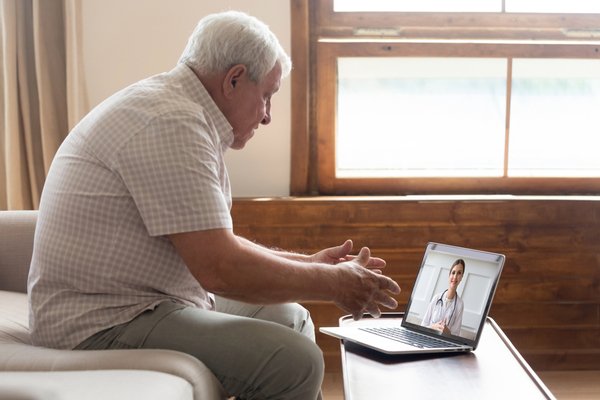The COVID-19 pandemic has increased the risks for seniors who receive in-home elder care. Caregivers use masks, handwashing, and social distancing to increase the safety of home visits, but for many, reducing the frequency of visits can be a valuable piece in the puzzle of pandemic safety protocol. Especially for seniors eligible for lower level packages of Home Care, telemedicine can meet a percentage of service needs while significantly reducing both cost and transmission risk. For many home care caregivers, innovative telemedicine tools are the means to provide socially-distant, high-quality care.
Telehealth video conferencing software
Even before COVID-19 made in-person appointments less common, telehealth video appointments were an important tool for improving access for homebound seniors. Elderly Australians who can’t drive or who have mobility challenges can more easily attend appointments from the comfort of home. Standard video conferencing software doesn’t always meet the security and privacy requirements of The Privacy Act 1988, but software that’s designed specifically for telehealth is secure and safe for virtual provider visits.
Telehealth visits can be funded by Home Care Packages. They’re especially useful for supplementing Level 1 and 2 packages, in combination with a service like companion care. A senior who’s receiving in-person support from a companion can often address healthcare needs with a video appointment, without the need for transportation or the increased risk of in-person visits.
The best telehealth conference tools are easy for people with minimal technology skills to use and don’t require patients to download or install new software. They should also be private and secure with end-to-end encryption. In addition, they should integrate smoothly with patient scheduling software and other provider tools. Some software tools that fit the bill include NexHealth, Coviu, and Healee.
Remote patient monitoring devices
For seniors who need a higher level of care, remote health devices can supplement in-person care with 24/7 monitoring. When an individual needs more support than occasional visits but isn’t ready to transition to live-in care, monitoring devices can help bridge the gap. Remote patient monitoring devices, or RPMs, can track health information from blood glucose level to eating habits, enabling physicians to monitor symptoms and identify risk factors before a condition becomes serious.
RPMs are especially useful for managing chronic conditions, since tracking changes over time is key to management. Unlike a visiting caregiver, who only collects a snapshot of data at the time of the visit, remote monitoring devices can collect a continual stream of information, providing comprehensive longitudinal data about a patient’s progress. A nurse or physician can then review the data and follow up with a telehealth conference or in-person visit if the need is indicated. RPMs can thus reduce the need for hospital visits as well as the need for home visits from a nurse or specialist.
RPMs can be simple and designed for a specific condition, such as a smart glucose monitor that automatically sends measurements to a nurse when the senior checks their blood glucose levels after a meal. RPMs can also be complex and multi-purpose, such as a full-home movement monitoring system that tracks where the senior moves throughout the day (providing information about mobility and rest habits) and alerts a nearby caregiver if the senior suffers a fall. RPMs can be wearable or installed in the home, or they can be used on a schedule or as-needed.
The type of remote monitoring an individual will most benefit from depends on their health needs. A senior with a cardiovascular condition might use a simple vitals monitor such as Caretaker to track their blood pressure, heart rate, respiration, and temperature at scheduled times throughout the day. A senior with a variety of chronic conditions who takes numerous medications might benefit from an app such as Medisafe that helps manage medication schedules and improve treatment adherence. A person with limited mobility and several health conditions might opt for a comprehensive senior monitoring solution like Sofihub.
The COVID-19 pandemic is propelling innovation in the field of telemedicine, as patients, caregivers, and physicians all seek to provide high-quality care without the risk of person-to-person contact. But the pandemic shouldn’t be the only driving force for remote healthcare. As a supplement to direct care, telemedicine can increase both access and care quality for elderly Australians who live in rural locations, who have limited mobility and transportation access, or who desire to balance their desire for privacy with their need for continual monitoring. The level of convenience, ease of access, and quality of care that telemedicine tools provide shouldn’t just be the opportunity of the moment; they should set the standard for the future.
About the author
Gareth Mahon is the co-founder and CEO of The CareSide, a company based in Perth that provides home care for the elderly and disability care services throughout Western Australia.











it is right on target. We have developed the only interactive preventive solution over the past fourteen years to address the critical issues in the delivery of care especially in remote areas as well as for the elderly. The pandemic has brought this issue to the front pages But the reality is that a video with a doctor or caregiver is with no monitoring history is not effective Actually quite dangerous Our interactive preventive solution allows a caregiver to interact and monitor a patient disease-specific and as such eliminate critical and expensive consequences. For a project, we developed for the Philippine Red Cross India and Pakistan we implemented a solution we call Mobile Clinic where a caregiver can attend to as many patients as they are assigned wherever they provide preventive services diseases specific but in case of need interact with a doctor or hospital provide them with the vital medical history on the patient and as such eliminate expensive and critical consequences. A solution like this not only can improve the efficiency of a home health facility but allow them the ability to provide services to those that choose to stay independent. The system is not only simple to use but more importantly affordable
Thanks for posting this article. It’s particularly important that the RPM technology also should have an engagement portion to drive the individual back to the system. Video chat, photos, entertainment and games can provide an added advantage to having the system, giving a benefit of socialization and fun to the monitoring.
GrandCare Systems was specifically designed to help professional and family caregivers to virtually connect, video chat, provide remote monitoring of vitals and activity patterns and ensure a resident’s safety. http://www.grandcare.com